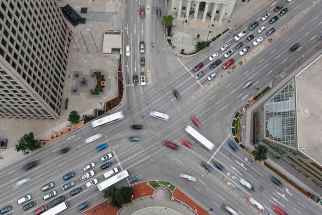Urban inertia While things big and small have changed downtown in recent decades, its broader perception seems mired in time
Read this article for free:
or
Already have an account? Log in here »
To continue reading, please subscribe:
Monthly Digital Subscription
$0 for the first 4 weeks*
- Enjoy unlimited reading on winnipegfreepress.com
- Read the E-Edition, our digital replica newspaper
- Access News Break, our award-winning app
- Play interactive puzzles
*No charge for 4 weeks then price increases to the regular rate of $19.00 plus GST every four weeks. Offer available to new and qualified returning subscribers only. Cancel any time.
Monthly Digital Subscription
$4.75/week*
- Enjoy unlimited reading on winnipegfreepress.com
- Read the E-Edition, our digital replica newspaper
- Access News Break, our award-winning app
- Play interactive puzzles
*Billed as $19 plus GST every four weeks. Cancel any time.
To continue reading, please subscribe:
Add Free Press access to your Brandon Sun subscription for only an additional
$1 for the first 4 weeks*
*Your next subscription payment will increase by $1.00 and you will be charged $16.99 plus GST for four weeks. After four weeks, your payment will increase to $23.99 plus GST every four weeks.
Read unlimited articles for free today:
or
Already have an account? Log in here »
Hey there, time traveller!
This article was published 14/10/2022 (1149 days ago), so information in it may no longer be current.
One of the most jarring signs that you’re getting older, perhaps, is when youth of the next generations start asking what you remember about the past. It’s been happening more to me, lately. It’s a strange feeling, to realize your memories are making the transition from a living description of your time, to an artifact of history; at least, it puts time into perspective.
For instance, there was that afternoon last week, when I went walking around downtown with two outreach workers from the Downtown Community Safety Partnership. It was something I wanted to do for an upcoming feature story, taking a look at one slice of the discussion over the state of downtown; to understand it, you need to get close to the ground.
The walkers were young, in their early 20s. They spend most of their workday on downtown’s streets, making connections with folks they meet, helping meet people’s needs where they can. As we walked, we chatted about the challenges that face downtown, and about how Winnipeggers see it. And that’s when they asked a question I didn’t expect.
“What was the perception of downtown like back when you started coming?” one of them asked.
JOHN WOODS / WINNIPEG FREE PRESS Winnipeg has long had a complex relationship with its downtown. While empty buildings can be redeveloped, more challenging issues, such as racism and segregation, will linger far longer.
It hadn’t occurred to me until that moment how much shorter their memory of Winnipeg’s relationship with its downtown was than mine: they wouldn’t remember the 1990s, and even their grasp of the 2000s would, at best, be distant and fuzzy. I wished I had some sort of nuanced insight I could offer, but there was really only one honest reply.
“The same,” I told them. It was the same. In that regard, nothing really has changed.
To be clear, that’s not to say downtown hasn’t changed: it has, in ways big and small, visible and invisible. It has declined in some places and risen in others. There are new buildings, new social space, new investment. But the perception of the place, the way Winnipeggers as a whole talk about it and why many avoid it, all of those were true in my youth and remain.
Crime, safety, the emptiness of the streets: these have always been at the top of the discussion. Visible poverty makes a big impact on outside perceptions. So too, if we’re being honest — which we must — does racism: I vividly recall many debates I’ve had with people who make thinly veiled comments about “the type of people” downtown that keep them away.
Whenever we convene a public discussion about downtown, it’s important, I think, to consider how we were introduced to the area, and how that shapes our relationship to it.
That part will take the longest to fix, I think. Buildings can be built or redeveloped, and investments can be made, but the city’s deepest wounds — the racism, the segregation, the compounding traumas, the pain — will always assert themselves there, in the heart, one of the relatively few places in the city where all its residents come to mingle in open space.
Whenever we convene a public discussion about downtown, it’s important, I think, to consider how we were introduced to the area, and how that shapes our relationship to it. Was it a part of our world when we were young, or was it distant? Was downtown somewhere we just drove through, or somewhere we saw as a home, or just an occasional destination?
My earliest memories of downtown are limited but, for the most part, a little bit magic. Downtown for me as a young child was going to the IMAX theatre at Portage Place, in awe of what was then the miraculous visual weight of the screen; it was occasional shopping trips with my parents to the old Eaton’s or Bay stores, or to go to some sort of children’s event.
BORIS MINKEVICH / WINNIPEG FREE PRESS The Imax Theatre at Portage Place.
Otherwise, I was a child of the suburbs, who grew up in a university enclave in Winnipeg’s south end. The core area of the city existed largely outside the boundaries of our lives; it felt distant, vaguely unsafe, somewhere you just shouldn’t go. But as I moved through adolescence, the fact that it did feel unknown started to call me: I wanted to understand it.
When I was 14, my father would drive me downtown and drop me off, at my request, somewhere along Portage, or in the Exchange, with a $20 bill in my pocket and a few hours to explore. He did this with trepidation, though he tried to keep it hidden; he didn’t want me to be afraid of my own city, he explained later. He wanted me to feel free to explore.
That was a gift, I think now. Because those afternoons, walking aimlessly around downtown, were my first introduction to the joys and the challenges of urban environments; it was how I learned, without doubt, that I am a creature best suited to the densest part of cities, even where they’re not so pretty. The textures transfixed me. All these years later, they still do.
I loved downtown, the more I met it. The colourful dive bars that cultivated their own crowds of regulars for friendship and live music. (Some of those are gone now.) The niche shops that somehow persisted. The alleys and buildings that revealed almost archeological layers of Winnipeg’s history, repurposed over generations: all of these were beautiful, to me.
But I saw then, as I see now, the fog of sadness that lies heavy over so much of downtown, setting a tone for Winnipeg as a whole; it’s bleak, to pick your way between empty shops and surface parking lots, where there should be buildings that are more useful and more welcoming to people. It’s surreal to me how those known problems are so little changed.
Maybe one day, we can turn to the next generation and say, “it took a long time to figure it out, but when we did, everything changed.”
For this reason, I love talking about downtown, and I hate talking about downtown. I love that we still believe in it as a place that will someday thrive, a place that can be vibrant, if given the right investments of money and vision and time. I hate how that discussion has been held time and time again, unchanged in the broadest strokes, for almost my whole life.
While I was writing this upcoming feature it occurred to me, a little grimly, that I wouldn’t want to hazard a guess at how many times the Free Press has published a “state of the downtown” story over the last three decades or so. This ground is so well-trodden, it’s been worn into a trench: vacant shops, crime, lack of pedestrian life, ’round and ’round in circles we go.
Yet there is hope, there is hope. As I walked downtown last week, chatting with people from several different vantage points, the common thread that emerged is one of perspective. It has to start with people, everyone said. If you make a place good for people, they’ll usually fill it. All you need is to craft the right invitation for them to come, and then the supports to stay.
And one day, perhaps, young Winnipeggers will ask older ones about their memories of downtown, and will be surprised to hear that we ever spent decades having more or less the same debates about its problems and its future. Maybe one day, we can turn to the next generation and say, “it took a long time to figure it out, but when we did, everything changed.”
melissa.martin@freepress.mb.ca
Our newsroom depends on a growing audience of readers to power our journalism. If you are not a paid reader, please consider becoming a subscriber.
Our newsroom depends on its audience of readers to power our journalism. Thank you for your support.












